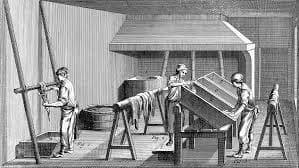Leather has undoubtedly played a crucial part in the development of civilization, as a true demonstration to human innovation and resourcefulness. It has been an enduring feature of almost every era of design and fashion, from early man to the modern day.
Leather making is an ancient art. It has been practiced for more than 7,000 years. At that time leathers were used to safeguard themselves from the elements. Prehistoric man chased after the wild animals to feed themselves, then made clothing, footwear and crude tents from the hides. dried animal hides were first recognized during pre-historic times. In the same era, man used leather for clothing and shelter against harsh conditions. The earliest record of the use of leather dates from the Paleolithic period, cave paintings discovered in caves near Lerida in Spain depict the use of leather clothing. Excavation of Paleolithic sites has yielded bone tools used for scraping hides and skins to remove hair.
During 1300 BC man began to use animal skins as much more than just a food-by product. The skins rapidly putrefied and became useless, so a method of preservation was needed. The earliest method was to stretch the hides and skins on the ground to dry, rubbing them with fats and animal’s brains while they dried. After fresh skins were dried in the sun, soften and preserved by salting and smoking as it preserved hides and skins. The world developed their own techniques to soften and preserved their products made from animal’s hide. By using traditional methods such as smoke and animal grease. Ancient Hebrew and the Egyptians settlers were the first one to discover the art of vegetable tanning around 400 BCE, beginning with simple drying and curing techniques. Much later the use of earth salts containing alum as a tanning agent to produce soft white leather was discovered. The alum leathers could be dyed with naturally occurring dyestuff’s in various plants.

During the Homeric era in around 1200 BC, the Ancient Greeks used leather to craft sandals and other garments. The Middle Ages Arabs preserved the art of leather making and improved in such a way that morocco and cordovan (from Cordoba, Spain) became highly prized leathers. The manufacture of leather was introduced to Britain by invaders, the Romans, and by religious communities, whose monks were expert at making leather, especially vellum and parchment for writing purposes. The process of manufacturing then started to spread to Egypt where it was appreciated by Pharaohs and Queens and later the leather was used as protective over-shirts and armoury by foot soldiers in Rome.
Through the centuries leather manufacture expanded steadily and by medieval times most towns and villages had a tannery, situated on the local stream or river, which they used as a source of water for processing and as a source of power for their water wheel driven machines. Many of these tanneries still exist, but in many towns the only remaining evidence is in street names, like Tanner Street, Bark Street and Leather Lane. The scale of manufacturing and the processes used to create leather changed as societies became progressively more civilized and advanced. As innovation expanded by the 15th century, power-driven machines that performed such operations as splitting, fleshing, and dehairing were established. Alternative method to vegetable tanning was invented in the 19th century. Chrome tanning involves using chemicals which trim the manufacturing process so that many of the preparatory steps required for traditional vegetable tanning are eradicated. Today, 80-90% of tanning worldwide involves the use of chromium.

Not only is leather used to produce clothing, but it also has its connection with the bookbinding industry during the Victorian era, due to its admiration. Novels by the iconic authors such as Charles Dickens and Oscar Wilde have been immortalized in gilded leather and first editions now fetch thousands of pounds at auction.
Throughout the history of transportation and furniture leather has been used for seating purposes due to its toughness and comfort. For making saddles and tack, as well as footwear leather has always been the ideal material. Leather became the prominent option for dining chairs, as it was easy to sustain and did not hold the odour of food.
The spread of industrialization in the 18th and 19th centuries created a demand for new kinds of leathers, such as belting leathers to drive machinery. Gradually due to rise in the standard of living the demand for softer, lightweight footwear with a fashionable appearance created a demand for soft, flexible, colourful leather. The tanned traditional vegetable leather was too hard and thick for these requirements. Hence, the use of chromium salt started and chrome tanning became the quality for modern footwear, fashion and upholstery leathers.
Modern technology has allowed for innovation in the leather industry, as the development of chemicals and sophisticated processing methods have greatly expanded the aesthetics and feel of leather as well as the possible applications. Leather continues to be the material of choice, not just for commercial and residential furniture but for automotive, aviation and marine applications as well.
Reference:
A Brief History Of Leather. (n.d.). Retrieved June 20, 2020, from https://mahileather.com/blogs/news/a-brief-history-of-leather
Leather. (2020, June 15). Retrieved June 20, 2020, from https://en.wikipedia.org/wiki/Leather
The Editors of Encyclopaedia Britannica. (2020, March 05). Leather. Retrieved June 20, 2020, from https://www.britannica.com/topic/leather
W-Fowler, A. (n.d.). Where does leather come from? Retrieved June 20, 2020, from http://www.all-about-leather.co.uk/what-is-leather/where-does-leather-come-from.htm

